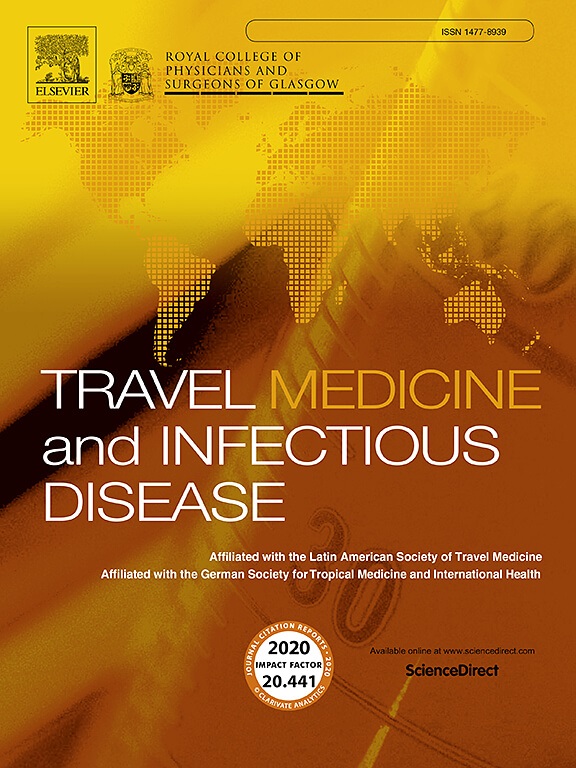Etiologies of acute febrile illness among hospitalized patients: A retrospective hospital-based study in Mogadishu, Somalia
IF 4.7
3区 医学
Q1 INFECTIOUS DISEASES
引用次数: 0
Abstract
Background
Acute febrile illness (AFI) is a major cause of hospitalization in tropical regions. While it is often initially diagnosed as malaria in Africa, its specific causes in Somalia remain largely unknown. This study aimed to identify the etiology and clinical outcomes of AFI among hospitalized adults in Mogadishu, Somalia.
Methods
Medical records of adult patients presented with fever (≥15 years, temperature ≥37.5 °C) who were hospitalized from January 1, 2021 to 31 December 2023 at Somalia Mogadishu-Turkish Teaching and Research Hospital, Somalia were retrospectively examined. We described the demographic data, clinical characteristics, laboratory parameters, treatment modalities, and outcomes among these patients. Univariate and multivariate analyses were then performed to identify factors associated with severe outcomes.
Results
A total of 1648 cases were initially collected. After applying the inclusion criteria and removing duplicates and mislabeled files, 702 cases (42.6 %) were included in the study. Etiologies were identified in 24.2 % of these cases, with the most common being acute hepatitis A (9.5 %) and malaria (7.7 %). Antibiotics were used in 83.3 % of patients. Factors associated with an identified etiology included pre-existing medical conditions, genitourinary involvement, and a shorter fever duration. Overall, 61.4 % of patients recovered, while the mortality rate was 10.5 %, with the highest rate attributed to urinary tract sepsis (2.7 %). Poor outcomes were significantly associated with an elevated white blood cell count, elevated serum creatinine, and advanced age.
Conclusion
These findings underscore diagnostic limitations and antimicrobial misuse, emphasizing the need for expanded laboratory capabilities with pathogen-specific testing to better identify AFI in Somalia.
住院病人急性发热性疾病的病因:索马里摩加迪沙一项回顾性医院研究。
背景:急性发热性疾病(AFI)是热带地区住院的主要原因。虽然它在非洲最初通常被诊断为疟疾,但其在索马里的具体原因在很大程度上仍然未知。本研究旨在确定索马里摩加迪沙住院成人AFI的病因和临床结果。方法:回顾性分析2021年1月1日至2023年12月31日在索马里摩加迪沙-土耳其教学与研究医院住院的发热(≥15岁,体温≥37.5°C)成人患者的病历。我们描述了这些患者的人口统计数据、临床特征、实验室参数、治疗方式和结果。然后进行单因素和多因素分析,以确定与严重结果相关的因素。结果:初步收集病例1648例。应用纳入标准,剔除重复和错标文件后,702例(42.6%)纳入研究。在这些病例中,24.2%的病例确定了病因,其中最常见的是急性甲型肝炎(9.5%)和疟疾(7.7%)。83.3%的患者使用抗生素。与确定的病因相关的因素包括既往医疗状况、泌尿生殖系统受累和发热持续时间较短。总体而言,61.4%的患者康复,而死亡率为10.5%,其中尿路败血症的死亡率最高(2.7%)。不良预后与白细胞计数升高、血清肌酐升高和高龄显著相关。结论:这些发现强调了诊断局限性和抗菌药物滥用,强调需要扩大实验室能力,进行病原体特异性检测,以更好地识别索马里的AFI。
本文章由计算机程序翻译,如有差异,请以英文原文为准。
求助全文
约1分钟内获得全文
求助全文
来源期刊

Travel Medicine and Infectious Disease
PUBLIC, ENVIRONMENTAL & OCCUPATIONAL HEALTH-INFECTIOUS DISEASES
CiteScore
19.40
自引率
1.70%
发文量
211
审稿时长
49 days
期刊介绍:
Travel Medicine and Infectious Disease
Publication Scope:
Publishes original papers, reviews, and consensus papers
Primary theme: infectious disease in the context of travel medicine
Focus Areas:
Epidemiology and surveillance of travel-related illness
Prevention and treatment of travel-associated infections
Malaria prevention and treatment
Travellers' diarrhoea
Infections associated with mass gatherings
Migration-related infections
Vaccines and vaccine-preventable disease
Global policy/regulations for disease prevention and control
Practical clinical issues for travel and tropical medicine practitioners
Coverage:
Addresses areas of controversy and debate in travel medicine
Aims to inform guidelines and policy pertinent to travel medicine and the prevention of infectious disease
Publication Features:
Offers a fast peer-review process
Provides early online publication of accepted manuscripts
Aims to publish cutting-edge papers
 求助内容:
求助内容: 应助结果提醒方式:
应助结果提醒方式:


